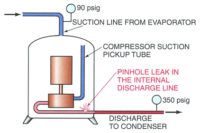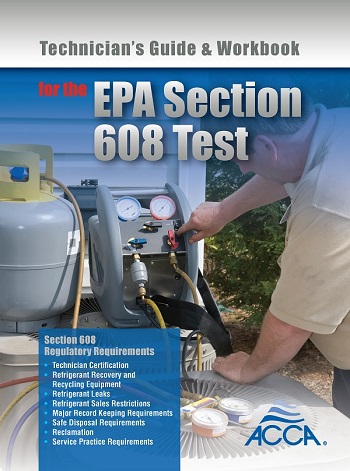Bob and Tim were on a service call at a new customer’s house. The complaint was that the humidity in the house seemed to be high because mold was growing — shoes in closets and wooden object were the worst. The summer weather was very hot, and there was also high humidity. They were talking to the homeowner and asking questions. The homeowner bought the house last year from an individual, not going through an agency. The house had a 4-ton air conditioner. The homeowner said, “The previous owner bragged about the air conditioning system in this house because it had a big enough capacity to handle any kind of weather, and if the power were off for a long period of time, the unit would bring the house temperature down quickly.”
Bob and Tim looked the house over and found newly installed storm windows, a new roof on the house, and awnings on several windows on the west side of the house. The new roof had a ridge vent to cool the attic, which looked new.
They asked the homeowner when the windows and roof had been put on the house, and the owner said, “I had the new roof put on, the ridge vent to vent the attic, and also new storm windows just this past year.”
Bob then asked the homeowner, “Have you ever noticed how often the air conditioner runs during the heat of the day? Does the unit stay on for long periods of time or several short periods of time during the day?”
The owner said, “The unit only runs for a short period of time, it has plenty of capacity. It never seems to run for long periods of time.”
Bob and Tim used their psychrometer and took humidity readings around the house. They found the house humidity to be running at about 65 percent. They explained to the homeowner that this was very high and would promote mold. They said they would try to see if they could figure out a way to reduce the humidity with the system he had.
Bob and Tim put gauges on the unit, started it, and observed. The suction and discharge pressures were normal for the conditions, and the superheat was correct for the operating conditions.
“It is obvious to me from what you have told me and what I have seen that the air conditioning system is oversized for this house. When you added storm windows, awnings, and the roof ventilation system — all of which are good — it only accented the oversized system. These home improvements all reduce the heat load on the house and would call for a smaller unit,” Bob said to the homeowner.
Bob and Tim went outside, and Bob said to Tim, “The system in this house is relatively new but oversized. It would be very hard to convince the homeowner to install a new, smaller system at great expense. I think that we should see if we can get this system to operate under different conditions that would remove more moisture from the air.”
“How can we make this system remove more moisture and still operate correctly?” Tim asked.
“The amount of moisture that a coil removes is based on the dew point temperature of the coil,” Bob said. “Under design conditions, typically a unit like this would operate with a 40°F coil temperature (Figure 1). If we could reduce the coil temperature and keep the coil from freezing during long periods of operation, we can lower the dew point temperature and remove more moisture. We can lower the coil temperature by reducing the airflow over the coil. Then, we can install a freeze control to shut the compressor down in case the coil gets too cold (Figure 2). We can set the fan to the lowest speed for summer operation. If we don’t reduce the airflow enough, we can block the return air duct just before the filter and further reduce the airflow. We can attach the freeze control to the suction line returning from the coil and wire it to only turn off the outdoor unit. When we turn off just the outdoor unit, if the thermostat is still calling for cooling, it will keep the indoor fan running. That will thaw any ice that may be on the coil, and, in a few minutes, the freeze control will start the compressor and continue to run as normal until another freeze condition happens. The outdoor unit will continue to cycle on and off with the indoor unit running continuously until the thermostat satisfies, and then the whole system will shut down and operate normally. The only interruptions would be at times when there may be a freeze condition for short periods of time, which would normally be early in the morning or late in the evening. I think we can get more running time out of the system at a colder coil temperature by making these changes. Let’s get started,” he said.
They checked the fan speed for the air handler in the summer cycle, and it was on medium-high. It was a four-speed fan, so they dropped the summer fan speed down to low and started the unit. There was a noticeable difference in reduced fan speed with the coil operating at about 35°. That is a reduction of 5° dew point of the coil. They then went to the homeowner and explained what they had done and why, pointing out that this was an experiment, but they felt real confident about it. They also explained that they were going to install the freeze control on the outdoor unit’s suction line just in case. As an extra step, they slid a piece of metal in the return air duct before the filter to further reduce airflow.
The suction pressure dropped to 33°, further reducing the dew point temperature.
Tim then asked a key question — “What do you think the efficiency of the system will be operating under these conditions?”
“The system will not be as efficient as it was because it is not operating under design conditions,” Bob said. “We won’t know what the efficiency of the system is, but we will know that the customer will not have to buy a new system to get better conditions in the house. When this system is changed out, it should be noted that somebody should run a load calculation on the house and put in the correct sized system at that time. Until then it won’t be as efficient, but it is much less expensive than changing the unit.”
“I understand that it won’t be quite as efficient during these operating times, but it will save money for the customer,” Time replied. “We could have probably easily sold the customer on a new system, but I think we’re taking better care of the customer by saving him money this way. He will be sure to call us as his service company in years to come when a new system is needed.”
The next day the customer called and said the air temperature in the house seemed cooler, and it seemed drier in the house. He was going to clean all of his shoes and leather goods and get any residual mold off of his belonging to see if it reappeared later. He said that the unit was running longer periods of time and that he was confident that they had made a good repair, and he thanked them.
Publication date: 07/24/2017
Want more HVAC industry news and information? Join The NEWS on Facebook, Twitter, and LinkedIn today!










